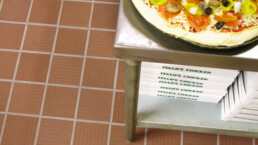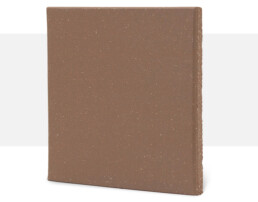Unglazed Quarry Tile: Durable & Stylish Choice for Commercial Kitchens
When choosing flooring for a commercial kitchen, durability, strength, and safety are some of the most important factors. Because unglazed quarry tile earns high marks in these three areas, it is a popular choice for commercial kitchens. It is also a versatile and stylish option that can help you achieve a variety of looks. This blog will explore the numerous benefits of using six-inch unglazed quarry tile for commercial kitchen flooring.

What is Unglazed Quarry Tile?
Quarry tile is a type of ceramic tile that is made from a dense mixture of clay and shale. It is fired at high temperatures to create a tile that is durable and resistant to stains, moisture, and heavy traffic. Unglazed quarry tile is available in many colors, but it is most commonly found in natural earth tones such as red, brown, black, and gray.
Unlike glazed ceramic tiles which have a shiny surface, unglazed quarry tiles have a matte finish. This unique texture not only adds to its aesthetic appeal but also enhances its slip-resisting properties.
While the most common size of quarry tiles is a 6’’ x 6’’ quarry tile (also sometimes referred to as 6’’ x 6’’ commercial kitchen tile), they come in other sizes and shapes as well.
The Benefits of Unglazed Quarry Tile for Commercial Kitchens
There are many benefits to using unglazed quarry tile in commercial kitchens, including:
- Durability: Unglazed quarry tile is one of the most durable and dense tiles available. Designed to withstand high foot traffic, heavy equipment, spills, and constant cleaning. It is resistant to chipping, scratching, and cracking, making it ideal for areas such as commercial kitchens.
- Resistance against slips and falls: Unglazed quarry tile also helps to prevent slipping, even in the most demanding kitchens. This is an important safety feature for commercial kitchens, where grease and other spills are common. Unglazed quarry tile can help to reduce the risk of accidents and injuries.
- Easy cleaning and maintenance: Unglazed quarry tile is easy to clean and maintain. It does not require any special sealants or waxes, and it can be cleaned with a simple mop and bucket. Quarry tile’s low absorption rate prevents moisture from seeping into the tile, preventing mold and mildew growth.
- Variety of colors, shapes, and sizes: New products can help create a variety of looks. This makes it a versatile choice for commercial kitchens of all styles.
6’’ x 6’’ Unglazed Quarry Tile for Commercial Kitchens
6’’ x 6’’ unglazed quarry tiles are a popular choice for commercial kitchens because of their size and versatility. They are large enough to create a durable and easy-to-clean floor, but also small enough to be easily and quickly installed, reducing downtime for the kitchen.
6’’ x 6’’ quarry tile can be set in both a checkerboard or running bond pattern, or, with rectangular quarry tiles, it can be used to create a variety of patterns. It can also be used to create borders and accents.

Tips For Choosing and Installing Unglazed Quarry Tile For Commercial Kitchens
When choosing unglazed quarry tile for a commercial kitchen, it is important to select a tile that is rated for commercial use. This will ensure that the tile is durable enough to withstand the rigors of a busy kitchen environment.
Unglazed quarry tile can be installed by a qualified tile installer. The tile is typically installed using a thinset mortar. After the tile has been installed, it should be sealed with a grout sealer.
Maintenance and Cleaning
Unglazed quarry tile is a low-maintenance flooring option. It can be cleaned with a simple mop and bucket and does not require any special sealants or waxes.
To clean unglazed quarry tile, simply mop with a mild detergent and water. Avoid using harsh chemicals or abrasive cleaners, as these can damage the tile.
To seal the grout, use a grout sealer that is specifically designed for unglazed quarry tile. Apply the sealer according to the manufacturer’s instructions.
Cost Considerations and ROI for Unglazed Quarry Tile
When considering commercial kitchen flooring options, cost is important. Let’s examine the upfront cost of unglazed inch unglazed quarry tile and its potential return on investment (ROI) based on its durability and longevity.
Upfront Cost Compared To Other Flooring Options In Commercial Kitchens
The upfront cost of unglazed quarry tile may be higher compared to some other flooring options for commercial kitchens. However, it is crucial to consider the long-term benefits and cost savings that come with choosing this durable flooring material.
Unlike some other flooring options that may require frequent repairs or replacement, quarry tile is known for its longevity. With proper maintenance and care, quarry tile can last for decades, reducing the need for costly replacements.
Potential Return on Investment Based on Durability and Longevity
The durability and longevity of 6’’x 6’’ unglazed quarry tile contribute to its excellent ROI. By investing in a flooring material that can withstand the rigors of a commercial kitchen, business owners can avoid the expenses associated with frequent repairs or tile replacements.
Additionally, the slip-resisting properties of unglazed quarry tile help reduce the risk of accidents and injuries in the workplace.
When considering the ROI for unglazed quarry tile, it is important to evaluate the overall cost of ownership over the expected lifespan of the tile. Taking into account the durability, low maintenance requirements, and potential savings, it becomes clear that this flooring option offers a favorable return on investment.
Unglazed quarry tile offers numerous advantages for commercial kitchen flooring. Its durability, resistance to stains and moisture, slip-resisting resisting properties, and ease of maintenance make it an ideal choice for high-traffic areas. While the upfront cost may be higher compared to other options, the long-term benefits and return on investment outweigh the initial investment. By choosing six-inch unglazed quarry tile, business owners can create a safe and functional workspace while enhancing the overall appearance of their commercial kitchens.
